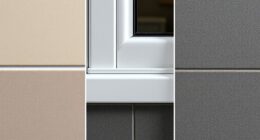To add a dash of culture to your home, incorporate stunning Indonesian textiles that tell rich stories. Use vibrant Ikat fabrics for accent pillows or table runners, bringing bold patterns into your space. Consider Batik wall hangings to showcase intricate designs inspired by nature. Luxurious Songket cushions can add sophistication, transforming your decor into something elegant. Embrace handwoven Tenun throws for warmth and texture. Finally, Ulos textiles not only enrich your decor but symbolize community and love. There are countless creative ways to elevate your home's aesthetic; keep exploring to discover even more enchanting ideas!
Key Takeaways
- Incorporate vibrant Ikat cushions to add mesmerizing patterns and colors that celebrate Indonesian heritage in your living space.
- Use Batik as stunning wall hangings or framed art pieces to showcase intricate designs and cultural narratives.
- Enhance your decor with luxurious Songket throw pillows and table runners, blending elegance with traditional craftsmanship.
- Display Ulos textiles as decorative throws or wall art to symbolize love and community, enriching your home's cultural ambiance.
- Create DIY textile projects, such as upcycled wall art or custom cushion covers, to personalize your space with rich Indonesian stories.
Understanding Indonesian Textiles

When you explore Indonesian textiles, you'll discover a vibrant tapestry that showcases the country's rich cultural heritage. These textiles are known for their intricate designs and bold colors, reflecting the diverse traditions of various regions.
One fascinating technique is Ikat, which involves resist-dyeing threads before weaving. This method creates mesmerizing, blurry-edged patterns that are highly sought after for home decor, and can beautifully complement Indonesian decorative pillows in your living space.
In addition to Ikat, you'll encounter luxurious Songket fabrics woven with gold or silver threads, primarily crafted in Sumatra. These textiles are known for their opulence and are traditionally used during ceremonial occasions to signify social status.
Another intriguing fabric is Ulos, cherished by the Batak people. With its vibrant colors and geometric patterns, Ulos symbolizes love and unity, often featuring prominently in rituals and significant community events.
As you immerse yourself in the world of Indonesian textiles, you'll appreciate not just their beauty but also the stories and meanings behind each piece. These textiles are known not only for their aesthetic appeal but also for their cultural significance, making them a wonderful addition to any home.
The Art of Batik

Batik stands out as one of Indonesia's most celebrated textile arts, originating from Java and recognized by UNESCO for its intricate patterns and cultural significance. This traditional wax-resist dyeing technique allows artisans to create detailed designs that often draw inspiration from nature and mythology, making each piece truly unique.
Incorporating batik into your home can be enhanced by pairing it with other traditional elements, such as Indonesian decor masks, which showcase vibrant artistry and rich cultural heritage. When you incorporate batik into your home, you not only enhance your interior design but also bring a piece of heritage into your space.
Explore distinct regional styles of batik, like those from Solo and Yogyakarta, which showcase variations in motifs, colors, and techniques. These differences reflect the rich tapestry of local cultural identities, allowing you to choose fabrics that resonate with your personal aesthetic.
Batik fabric is versatile; it can be used in clothing, home textiles, and decorative items, seamlessly integrating into your interior design scheme.
Moreover, the art of batik serves as a means of storytelling and cultural expression. Each visually rich pattern carries a narrative, inviting conversations and admiration. By adding batik to your home, you celebrate not just its beauty but also the craftsmanship and stories woven into every thread.
Embracing Ikat Patterns

Ikat patterns truly stand out for their enchanting beauty and rich cultural significance. This traditional Indonesian textile technique involves resist-dyeing threads before weaving, resulting in unique patterns with a characteristic blurry edge.
By embracing Ikat, you can infuse your home with vibrant colors and intricate designs that enhance your upholstery and bring a sense of exotic allure to your interior spaces. Additionally, these textiles reflect the artistry of Indonesian craftsmanship, showcasing diverse regional styles and traditions.
Incorporating Ikat into your home decor can also encourage appreciation for cultural heritage, aligning beautifully with the rich Indonesian cultural heritage.
Here are three ways to incorporate Ikat patterns into your design styles:
- Accent Pillows: Choose Ikat fabric to make or buy accent pillows. They'll add a pop of color and texture to your living room or bedroom.
- Statement Upholstery: Use Ikat textiles to reupholster a chair or sofa. This instantly transforms an ordinary piece into a stunning focal point.
- Table Runner: Incorporate a beautiful Ikat table runner for your dining table. It's an effortless way to showcase cultural heritage during meals.
The Beauty of Songket

When you explore the beauty of Songket, you'll appreciate its luxurious weaving techniques that create stunning patterns with gold and silver threads.
This exquisite fabric, much like the importance of Indonesian decor masks, showcases the rich cultural heritage of Indonesia.
Each motif tells a story, often drawing inspiration from nature and cultural symbols, giving the fabric a rich significance.
Styling with Songket adds an elegant touch to any outfit, making it perfect for special occasions where you want to stand out.
Luxurious Weaving Techniques
The beauty of Songket lies in its luxurious weaving techniques that reflect Indonesia's rich cultural heritage. This exquisite fabric, often woven with gold or silver threads, adds a touch of elegance to your home decor.
As you incorporate Songket into your design, consider these three key aspects:
- Handwoven Craftsmanship: Skilled artisans use ancient techniques to create Songket, combining weaving and brocade for a unique texture. This craftsmanship guarantees each piece is a work of art, similar to the intricate carvings found in traditional Indonesian style home decor.
- Natural Inspiration: The intricate motifs often draw from nature and local culture, showcasing the artistic depth of Indonesian traditions. The earth tones found in many designs can seamlessly blend with modern design elements.
- Cultural Significance: Beyond its aesthetic appeal, Songket represents social status and wealth. Using it in your home decor can create a conversation piece that highlights cultural appreciation.
Symbolism in Motifs
Incorporating Songket into your decor not only enhances elegance but also invites a deeper understanding of its motifs, which are rich with symbolism.
This luxurious fabric, traditionally woven in Sumatra with gold or silver threads, tells stories that go beyond mere aesthetics. Each Songket piece features intricate designs inspired by nature and local culture, reflecting various aspects of life and heritage, much like the traditional Indonesian housing that embodies cultural significance and community identity.
The symbolism in motifs is significant; for instance, floral patterns may represent growth and prosperity, while geometric shapes can signify strength and unity.
These motifs often convey the values and beliefs of the community, making each textile a living piece of history. Additionally, wearing or displaying Songket can signify social status and wealth, particularly during ceremonial occasions and special events.
Styling With Songket
With its rich textures and vibrant colors, Songket transforms any space into a luxurious retreat. This exquisite Indonesian textile, woven with gold or silver threads, brings a unique allure to your home decor.
Traditionally crafted in Sumatra, Songket isn't just a fabric; it's a celebration of culture and artistry, much like the intricate designs found in Indonesian wedding decor ideas.
Here are three ways you can style with Songket to elevate your home:
- Cushions and Throws: Use Songket as covers for cushions or throws on your sofa. The intricate motifs inspired by nature will add depth and elegance to your living room.
- Wall Hangings: Hang a piece of Songket on your wall as a statement art piece. Its opulence and vibrant colors can serve as a beautiful focal point in any room.
- Table Runners: Incorporate Songket into your dining area with a stunning table runner. This not only adds sophistication but also honors the artisan skills behind this traditional textile.
Handwoven Tenun Textiles

When you explore handwoven Tenun textiles, you'll discover unique weaving techniques that vary across Indonesia's islands.
These textiles are often made using local materials, reflecting the diverse architectural styles found in traditional Indonesian houses.
Each piece not only showcases intricate patterns but also embodies the rich cultural heritage of the region, making them a beautiful addition to your home that resonates with traditional craftsmanship.
Unique Weaving Techniques
While exploring the vibrant world of Indonesian textiles, you'll discover the enchanting art of Tenun, which showcases a variety of unique weaving techniques across the nation's diverse islands.
Each region boasts its own distinct styles and methods, reflecting a rich cultural heritage that resonates with the principles of tropical contemporary house design. This diversity results in incredible artistry, making Tenun a fascinating subject for home decor.
Here are three notable unique weaving techniques you should know:
- Ikat: This technique involves dyeing the threads before weaving, creating beautiful patterns that can appear blurred or softened.
- Lurik: Originating from Java, Lurik features simple, striped patterns and is traditionally made from cotton, often used in everyday clothing.
- Songket: A luxurious fabric woven with gold or silver threads, Songket is often reserved for special occasions and ceremonial items.
Cultural Significance and Heritage
Handwoven Tenun textiles hold immense cultural significance in Indonesia, representing not just artistry but also identity and heritage. Each piece showcases unique weaving techniques and patterns, varying by region, which tells a story about the local culture. Made from locally sourced materials like cotton and silk, these fabrics reflect the rich natural resources of their origin, emphasizing the use of natural materials that are central to Southeast Asian decor.
Tenun textiles play an essential role in everyday life, often used for clothing, accessories, and ceremonial items. This versatility highlights their importance in various cultural practices and rituals, reinforcing the connection between the textiles and the communities that produce them.
As you explore Tenun, you'll notice how vibrant colors and intricate designs convey deep cultural narratives and identity.
Moreover, Tenun serves as a critical medium for local artisans to preserve their traditional skills. By passing down knowledge through generations, they guarantee the continuity of Indonesian craftsmanship.
Ulos: Cultural Significance

Ulos, a vibrant textile cherished by the Batak people of North Sumatra, holds profound cultural significance in Indonesian society. This traditional fabric isn't just a beautiful addition to your home; it embodies values and traditions that resonate deeply within the community.
Here are a few key aspects of Ulos that highlight its cultural significance:
- Ritual Use: Ulos is often used in rituals and significant ceremonies, marking important life events such as weddings and births.
- Symbol of Unity: The vibrant colors and geometric patterns symbolize love, friendship, and unity among communities, reinforcing social bonds.
- Cultural Heritage: Recognized by the Indonesian government as a cultural heritage, Ulos represents the rich traditions and craftsmanship of the Batak people.
Woven with cotton or silk, each design reflects the unique identity of the Batak culture.
Ulos isn't only a fashion statement; it's a cherished gift that signifies deep connections and cultural practices.
Incorporating Textiles in Decor

Textiles play a pivotal role in enhancing your home decor, bringing warmth and personality to your living space. By incorporating Indonesian textiles, you can create a vibrant atmosphere that reflects rich cultural heritage.
For instance, consider using Ikat fabrics to add mesmerizing patterns and colors that transform any room into a visual feast.
Batik fabrics make stunning wall hangings or framed art. They showcase intricate designs inspired by nature and mythology, offering a conversation starter that celebrates Indonesia's artistic legacy.
You can elevate your decor items further with Songket fabrics, perfect for luxurious throw pillows or table runners. Their metallic threads symbolize elegance and social status, adding a touch of sophistication.
Handwoven Tenun fabrics also deserve a spot in your home. Drape them over furniture or use them as decorative throws, showcasing unique regional patterns and supporting local artisans.
Finally, Ulos textiles can serve as ceremonial pieces or accent decor, symbolizing love and unity. Their vibrant colors and geometric designs enhance your home's cultural narrative, making your decor not just beautiful, but meaningful.
Embrace these textiles, and watch your space come alive with character and charm.
DIY Home Projects With Textiles

You can easily transform your space with DIY projects using Indonesian textiles.
Try creating upcycled textile wall art by framing vibrant fabric scraps, or whip up custom cushion covers that reflect your personal style.
These projects not only add character to your home but also celebrate the rich heritage of the fabrics.
Upcycled Textile Wall Art
Transforming Indonesian textiles into wall art is a fantastic way to add a touch of culture and creativity to your home. Upcycling pieces like Batik or Ikat not only creates stunning focal points, but also celebrates cultural heritage.
Here's how you can get started:
- Select Vibrant Fabrics: Choose eye-catching Ikat or Batik pieces. Their rich colors and patterns will make your wall art pop.
- Stretch Over Canvas: Secure the fabric over a canvas frame with staples for a polished look. This method is straightforward and gives a professional finish.
- Create a Patchwork Piece: Use leftover fabric scraps to craft a unique patchwork wall hanging. This showcases various patterns and colors, adding depth to your decor.
To elevate your textile wall art, pair it with complementary decor elements. Think carved wooden frames or handmade ceramics to enhance the cultural aesthetic of your space.
With these upcycling hacks, you can transform your walls into an artistic celebration of Indonesian textiles that tells a story and brings warmth to your home.
Custom Cushion Covers
Custom cushion covers can instantly elevate your living space, infusing it with vibrant colors and rich cultural narratives.
Start by selecting Ikat fabric, known for its blurred-edge patterns that exude exotic allure. These covers can add character and a unique flair to any sofa or chair.
If you're drawn to storytelling, consider Batik fabric. Its intricate designs often reflect elements of nature and mythology, enriching your home decor with cultural depth.
For those special occasions, experiment with Songket, a luxurious fabric woven with gold or silver threads, giving your cushions an elegant touch.
Alternatively, incorporate Ulos fabric, celebrated for its vibrant colors and geometric patterns. These covers symbolize love and unity, making them perfect for family spaces.
Lastly, utilize Tenun textiles, handwoven from cotton or silk, to craft unique custom cushion covers that celebrate local artisanship.
You can mix and match these fabrics, focusing on earthy tones to create a cohesive look throughout your home.
With these DIY projects, you'll not only personalize your space but also showcase the beauty of Indonesian textiles.
Get creative and transform your living area with these stunning cushion covers!
Blending Traditional and Modern Styles

While embracing modern design, incorporating traditional Indonesian textiles can create a striking visual narrative that honors cultural richness.
The art of infusing these vibrant fabrics into your home allows for a unique blend of styles. Here are some ways to achieve that:
- Layer with Textiles: Use handwoven Tenun textiles to add warmth and texture to minimalist spaces. Their artisanal quality showcases authenticity and beauty in imperfection.
- Mix and Match: Combine sleek modern furniture with traditional Songket cushions or throws. This pairing elevates sophistication and merges luxurious materials with contemporary aesthetics.
- Bold Statements: Display Ulos textiles as wall art or soft furnishings. Their geometric designs not only serve as conversation starters but also maintain a cohesive look in your modern interiors.
Care and Maintenance Tips

Incorporating traditional Indonesian textiles into your home is just the beginning; proper care and maintenance are key to guaranteeing these beautiful fabrics last. By ensuring that your traditional Indonesian textiles are properly cared for, you can preserve their vibrant colors and intricate designs for years to come. Incorporating these textiles into your home decor can also create unique retreat themes that transport you to faraway places and add a touch of cultural richness to your living spaces. From batik bedspreads to ikat throw pillows, the possibilities for incorporating these textiles into your home are endless, allowing you to create a truly one-of-a-kind environment.
For Ikat and Batik fabrics, always hand wash them in cold water with a mild detergent. This helps preserve the vibrancy of the colors and the integrity of the patterns. Avoid exposing these textiles to direct sunlight for long periods, as this can lead to fading and deterioration of intricate designs.
When it comes to storing handmade textiles like Ulos, roll them instead of folding to prevent creases and maintain their shape. Make sure to keep them in a cool, dry place away from moisture.
If you need to de-wrinkle Kimono or Songket fabrics, use a gentle iron on a low setting, placing a thin cloth between the iron and the fabric to avoid direct heat damage.
Lastly, regularly inspect and gently brush your handwoven Tenun items to remove dust and dirt. This simple care routine will guarantee your textiles remain clean and vibrant for years to come, allowing you to enjoy their beauty in your home.
Frequently Asked Questions
What Is the Indonesian Textile Technique?
Indonesian textile techniques include Batik's wax-resist dyeing, Ikat's tie-dye weaving, luxurious Songket with metallic threads, diverse Tenun handwoven fabrics, and Ulos, symbolizing love. Each method reflects rich cultural heritage and unique regional characteristics.
What Are the Traditional Indonesian Textiles?
Traditional Indonesian textiles include Batik, Ikat, Songket, Tenun, and Ulos. Each features unique techniques and patterns, reflecting the rich cultural heritage. You'll find stunning artistry that tells stories of nature, mythology, and community.
What Is the Fabric Design in Indonesia?
You'll find Indonesia's fabric designs enchanting. From Batik's intricate wax-resist patterns to Ikat's blurred motifs and Songket's shimmering threads, each textile tells a story, reflecting rich cultural heritage and local artistry that's truly unique.
Conclusion
By weaving Indonesian textiles into your home, you're not just adding beauty; you're telling a story that spans generations. The vibrant patterns and rich textures of batik, ikat, songket, and tenun can transform your space, merging tradition with modern flair. As you explore DIY projects and decor ideas, remember that these textiles are more than decor—they're a celebration of culture. So go ahead, embrace these unique pieces and let them inspire warmth and creativity in your home.










